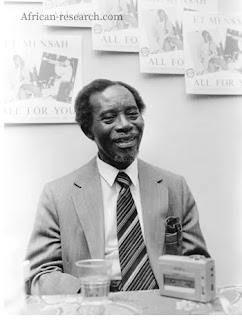Emmanuel Tettey Mensah (31 May 1919 – 19 July 1996), was a Ghanaian musician who was respectfully known as "the father of modern highlife," Mensah played a vital role in the evolution of Ghana's music.
A native of the small village of Ussher Town in Accra, Ghana, his early education took place at the Government School, and later at Accra High School. At the age of 12 he learned to play flute in the Government School band and in 1932 he began playing piccolo and flute in the Accra Orchestra, a schoolchildren's band. The leader of the Accra Orchestra at the time was a teacher, Joe Lamptey, who gathered talented young people together to form a band. Mensah continued to play with this orchestra..
Switching to trumpet and saxophone in his teens, he quickly attracted attention with his expressive playing. At the age of 18, he and his elder brother Yebuah formed the Accra Rhythm Orchestra, a group comprised of five saxophones, guitar, and African drums. They won the Lambeth Walk Dance Competition in 1939 at the King George Memorial Hall, now known as the Parliament House in Ghana. Around this time E.T. Mensah also played with the Kumasi Philharmonic Orchestra .
Although he joined Scottish trumpet player Jack Leopard's band in 1940, he remained only a few months before accepting an invitation to become a charter member of a highlife band, the Tempos. He soon assumed leadership of the group. In contrast to early highlife groups, which were modeled after jazz big bands of the 1940s, the Tempos was one of the first to adapt highlife rhythms to a small-ensemble approach. An essential element of the band's sound was Mensah's singing in a variety of indigenous Ghanaian languages. Although the original lineup of Tempo disbanded in 1942, Mensah reorganized the group six years later as it’s leader.
In 1952, the Tempos made their first recording with Decca. Mensah and the group toured successfully throughout Great Britain in 1953. Among their many hit singles were "Donkey Calypso," "School Girl," and "Sunday Mirror." In 1954, E.T. formed a second band called the Star Rockets.
 |
| Armstrong with Mensah (far left) |
Trained as a pharmacist, Mensah occasionally worked in the field to supplement his income as a musician. Music, however, remained his prime focus. Mensah attracted global attention when he performed with Louis Armstrong during celebrations of Ghana's independence in 1957. E.T. composed a highlife song entitled "Ghana Freedom Highlife". Two years later, he composed a song to celebrate Queen Elizabeth's visit to Ghana.
Although he maintained a low profile in the early '60s, Mensah began the first of several comebacks and in 1969 the Tempos went on a tour in the U.K. While in London the band recorded an LP called “The King of Highlife – African Rhythms” in Decca studios. By the mid-1970’s, the Tempos was still playing regularly. The band had a Cuban rhythm section with the front line comprising two trumpets and three vocalists. The Tempos used electric lead and rhythm guitars and electric bass. The repertoire of the band became larger and included Congo music, reggae, souls, Afrobeat and pop music of the younger generation. In all, E.T. Mensah recorded eleven LPs.
He had a collaborative album with Nigerian musician, Dr. Victor Olaiya, a pioneer of what is now known as Afrobeats titled, ‘Highlife Giants of Africa Vol. 1’ released in 1983.Despite being confined to a wheelchair, he embarked on a world tour in 1986. In 1986, a biography of Mensah by musicologist John Collins, E.T. Mensah: King of Highlife, was published by Off the Record Press in London and Ghana State Publishing Company in Accra. In the early '90s, Mensah recalled his revamping of highlife, explaining, "We urgently wanted an indigenous rhythm to replace the fading foreign music of waltz, rhumba, etc. We evolved a music type relying on basic African rhythms, a crisscross African cultural sound."
When he died on July 19, 1996, at the age of 78, following a long illness, at his family house in Mamprobi Accra, Ghana lost one of its most influential musicians.
(Edited from Wikipedia, AllMusic & J.Collins article )








.jpg)












































